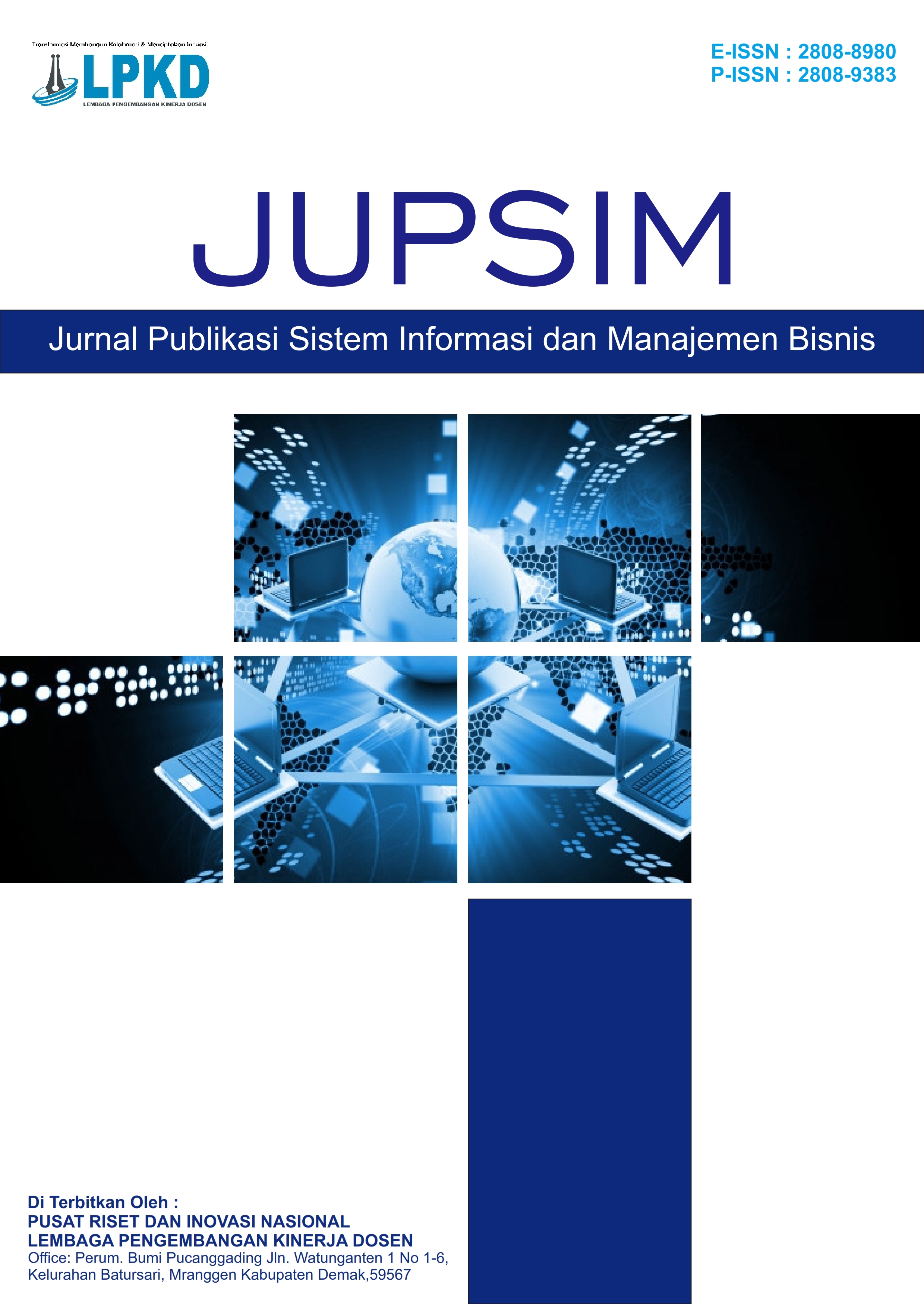Standard Operating Procedures for Tugboat Clearance and Service Enhancement at Jepara Port
DOI:
https://doi.org/10.55606/jupsim.v4i3.5346Keywords:
Jepara Port, Maritime Sustainability, Port Resilience, Service Quality, SOP, Tugboat ClearanceAbstract
Background: Clearance in and clearance out procedures are critical components of port operations that directly affect service quality, vessel turnaround time, and port sustainability. Jepara Port, as a regional hub, faces challenges in implementing effective clearance procedures for tugboats, notably TB. Bintang Harbour 4009, operated by PT. Sinar Bintang Samudera. Original value: Prior research has extensively examined container terminal performance and green port policies, but limited studies address tugboat clearance processes in smaller regional ports, despite their strategic role in supporting larger maritime logistics chains and sustainable port development frameworks. Objectives: This research investigates the clearance in/out procedures at Jepara Port, analyzes their influence on service quality, and evaluates whether adherence to SOPs can enhance efficiency and sustainability within the context of integrated maritime policy frameworks. Methodology: A qualitative descriptive approach was employed, using semi-structured interviews, questionnaires, direct observations, and document analysis. Data were analyzed through thematic analysis, cross-group comparisons, and narrative synthesis, incorporating sustainability assessment frameworks. Results: Findings revealed that while SOPs exist, their implementation is hindered by documentation errors, inconsistent inter-agency coordination, and partial digitalization. These issues contribute to prolonged clearance times and reduced compliance rates. However, improvements in first-time-right documentation and single-channel digital communication were shown to significantly enhance clearance performance and environmental outcomes. Conclusions: Clearance procedures are more than administrative requirements; they are strategic levers for port service quality, sustainability, and maritime vocational education. Strengthening these procedures can improve efficiency, reduce emissions, enhance port resilience, and support sustainable maritime development goals.
References
Amorim, L. M., Costa, J. L., Costa, A. C., Botelho, A. Z., & Torres, P. (2024). Unveiling microplastic abundance and distribution in an oceanic island: Offshore depository or local pollution indicator. Sustainability, 16(10), 4103. https://doi.org/10.3390/su16104103
Bilal, A., Xiao-ping, L., Nanli, Z., Sharma, R., & Jahanger, A. (2021). Green technology innovation, globalization, and CO2 emissions: Recent insights from the OBOR economies. Sustainability, 14(1), 236. https://doi.org/10.3390/su14010236
Caldas, P., Pedro, M. I., & Marques, R. C. (2024). An assessment of container seaport efficiency determinants. Sustainability, 16(11), 4427. https://doi.org/10.3390/su16114427
Caldeirinha, V., Felício, J. A., Pinho, T., & Rodrigues, R. (2024). Fuzzy-set QCA on performance and sustainability determinants of ports supporting floating offshore wind farms. Sustainability, 16(7), 2947. https://doi.org/10.3390/su16072947
Chae, G.-Y., An, S.-H., & Lee, C.-Y. (2021). Demand forecasting for liquified natural gas bunkering by country and region using meta-analysis and artificial intelligence. Sustainability, 13(16), 9058. https://doi.org/10.3390/su13169058
Creswell, J. W., & Poth, C. N. (2018). Qualitative inquiry and research design: Choosing among five approaches (4th ed.). SAGE.
Du, S., Zhang, H. S., & Kong, Y. (2023). Sustainability implications of the Arctic shipping route for Shanghai port logistics in the post-pandemic era. Sustainability, 15(22), 16017. https://doi.org/10.3390/su152216017
Hilmi, N., Farahmand, S., Lam, V. W. Y., Cinar, M., Safa, A., & Gilloteaux, J. (2021). The impacts of environmental and socio-economic risks on the fisheries in the Mediterranean region. Sustainability, 13(19), 10670. https://doi.org/10.3390/su131910670
Kim, B., Kim, G., & Kang, M.-H. (2022). Study on comparing the performance of fully automated container terminals during the COVID-19 pandemic. Sustainability, 14(15), 9415. https://doi.org/10.3390/su14159415
Kim, S.-K., Choi, S., & Kim, C. (2021). The framework for measuring port resilience in Korean port case. Sustainability, 13(21), 11883. https://doi.org/10.3390/su132111883
Liao, Y.-H., & Lee, H.-S. (2023). Using a directional distance function to measure the environmental efficiency of international liner shipping companies and assess regulatory impact. Sustainability, 15(4), 3821. https://doi.org/10.3390/su15043821
Mwendapole, M. J., & Jin, Z. (2021). Evaluation of seaport service quality in Tanzania: From the Dar es Salaam seaport perspective. Sustainability, 13(18), 10076. https://doi.org/10.3390/su131810076
Paridaens, H., & Notteboom, T. (2021). National integrated maritime policies: Vision formulation, regional embeddedness, and institutional attributes for effective policy integration. Sustainability, 13(17), 9557. https://doi.org/10.3390/su13179557
Patton, M. Q. (2015). Qualitative research & evaluation methods (4th ed.). SAGE.
Pian, F., Xu, L., Chen, Y., & Lee, S.-H. (2020). Global emission taxes and port privatization policies under international competition. Sustainability, 12(16), 6595. https://doi.org/10.3390/su12166595
Qi, J., Wang, S., & Zheng, J. (2022). Shore power deployment problem—A case study of a Chinese container shipping network. Sustainability, 14(11), 6928. https://doi.org/10.3390/su14116928
Wilson, T., Cooley, S. R., Tai, T. C., Cheung, W. W. L., & Tyedmers, P. (2020). Potential socioeconomic impacts from ocean acidification and climate change effects on Atlantic Canadian fisheries. PLoS ONE, 15(1), e0226544. https://doi.org/10.1371/journal.pone.0226544
Yin, R. K. (2018). Case study research and applications: Design and methods (6th ed.). SAGE.
Zhang, W., Zhang, Y., & Qiao, W. (2022). Risk scenario evaluation for intelligent ships by mapping hierarchical holographic modeling into risk filtering, ranking and management. Sustainability, 14(4), 2103. https://doi.org/10.3390/su14042103
Zhou, K., Yuan, X., Guo, Z., Wu, J., & Li, R. (2024). Research on sustainable port: Evaluation of green port policies on China's coasts. Sustainability, 16(10), 4017. https://doi.org/10.3390/su16104017
Zhu, J., Yan, W., He, J., Hafeez, M., & Sohail, S. (2024). RETRACTED: Exploring the convergence of ICT, digital financial inclusion, environmental pressures, and free trade and their significance in driving sustainable green investment initiatives under carbon neutrality targets. Heliyon, 10(11), e31102. https://doi.org/10.1016/j.heliyon.2024.e31102
Downloads
Published
How to Cite
Issue
Section
License
Copyright (c) 2025 Jurnal Publikasi Sistem Informasi dan Manajemen Bisnis

This work is licensed under a Creative Commons Attribution-ShareAlike 4.0 International License.







